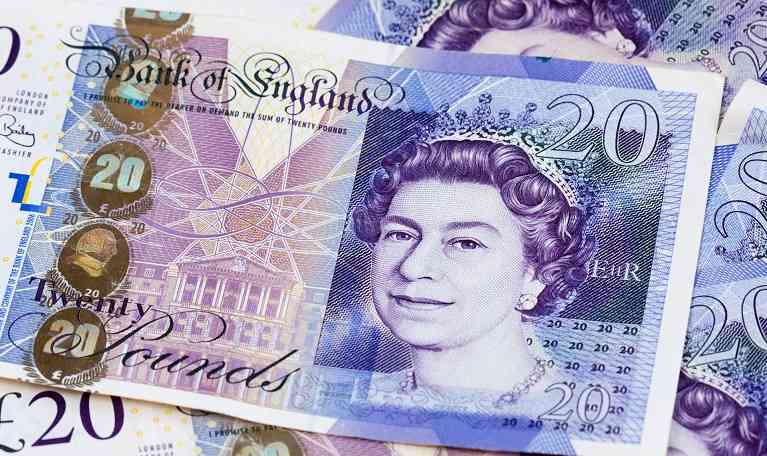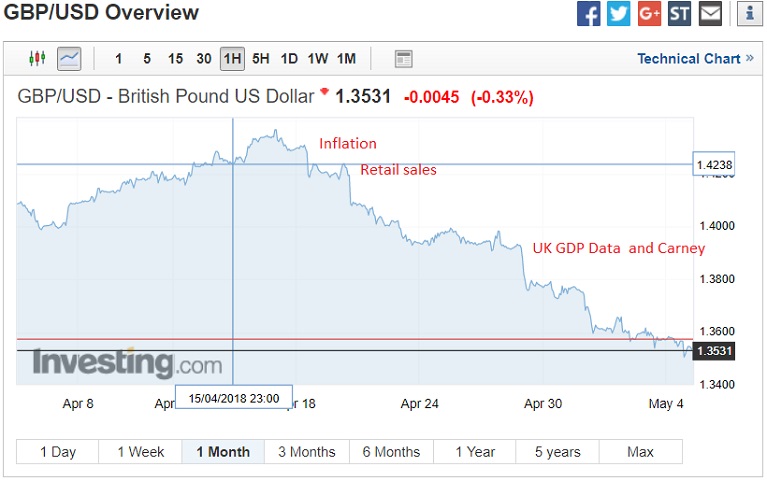What many had anticipated to be a great month of for sterling, instead appeared to tease markets rather than signify any notable gains for sterling. The Pound has faltered in terms of data readings but initially had managed to ride the wave of Brexit positivity. The most detrimental data to the pound this month included the service PMI, CPI y/y inflation data, retail sales and the poor GBP figures.

The poor run of data ultimately ensuring the return of the ‘unreliable boyfriend’ Mark Carney and an apparent cooling appetite for a May interest rate rise. Whilst many of the key data releases’ inability to meet forecast has blamed on the freakishly bad weather, investors will now be concerned as to when the next rate rise may be.
UK services PMI misses
A significant part of the UK’s economy is represented by the UK service industry, notably in London. This month’s weak figure which was explained away due to the terrible weather from the ‘beast of the East’ showed the largest services PMI drop since June 2016 (EY referendum outcome). Forecast to reach 53.9 the data missed its forecast significantly coming in at 51.7 showing a significant slump from the Marches 54.5.
While as many of this month’s data releases will be blamed on the uncharacteristic March weather the services PMI would seem one of the most likely to recover. Over the last 12 months, this sector has met or exceeded its forecast 9 times indicating that it should recover some of the losses.
Year on year UK CPI drops
The next run of GBP misfortune manifested itself in the latest y/y CPI data. The economic data had been forecast to remain flat at 2.7% however, it fell to 2.5% showing a deceleration in UK inflation. Whilst many at this point still believed that a May interest rate rise was still very much in the Bank of England’s plans. It continued to provide a reason not to raise rates in the short term. Although many experts would argue that inflation that sits around or above the ideal of 2% should effectively, not impede any rate decision.
UK retail sales drop as shoppers avoid the outdoors
Another piece of economics data whose poor performance was pinned on the adverse weather conditions was the retail sales data. Missing forecast significantly and showed a considerable decline from the month before when the data showed a -1.2% decline against a target of -0.5%, March’s data had surprised markets and reached 0.8% well over its 0.4 % target.
As with the services PMI retail sales have been dependable, seven of the last twelve months coming in over target with the largest upturn being seen in December 1.1%. Next month’s the UK retails sales will hopefully show a return to form a demonstrate some resistance in consumer goods appetite.
Carney non-committal fuels GBP sell-off
Investors for the last few weeks would have thought a UK interest rate rise was all but a foregone conclusion with all indicators leaning towards a May UK interest rate rise. However, as covered above the possibility now seems remote. Being finally compounded Carney, the Governor of the Bank of England highlighted the mixed data from the UK. When drawn on the potential timing of the UK interest rate rise Carney KO’d the Pound stating that the BOE weren’t:
“too focused on the precise timing”.
Rather than commenting on the next rate rise timing, Carney simply conceded that UK should “prepare for a few interest rate rises over the next few years”.
In some ways Carney confessed that the much of the UK economical scenario remain out of the banks hands, stating that:
‘’The course of the next few years are going to be taken in the Brexit negotiations and whatever deal we end up with’’.
UK GDP data slows dramatically
With all the economic indicators pointing one way, a betting man wouldn’t have put money on a staggeringly positive UK GDP figure. UK quarterly preliminary GDP was forecast to demonstrate the slight growth of 0.3%, slipping slightly from Januarys 0.5%. However, the preliminary GDP nosedived showing just 0.1% growth, the economy essentially at standstill.
The weather was once again named as the culprit, with the construction sector being hit hard by both the weather and the demise of Carillion with numerous contracts apparently in Limbo.
Construction fell by -1.6% this month, the second consecutive the sector has suffered. Whilst most of this can be put down to seasonal weather.
The ONS, however, disputed the claim saying that whilst weather has played a part in the short-term downfall of the sector it underlines a trend falling 3% since February 2017.
Pound-Dollar performance over the month of April
Typically, April has proved a great month for sterling with the currency performing well. This up until mid-April was indeed proving the case with GBP/USD approaching pre-Brexit levels. Negative talk surrounding Brexit, was out of the press and Sterling has continued to gain real momentum. Whether or not the majority of April’s slow economic growth can be blamed on the formidable ‘Beast from the East’ will be seen in the coming month. The fall out of the run of the weak UK economic data has been reflected in the Pound. The GBP-USD pair touched a high of 1.4366, a position the sterling would have almost certainly consolidated if the run of data had been positive.
Due to the factors we’ve covered, the pound has hit headwinds due to both the BOE governor’s sentiment to interest rate rises and the poor run of data. Pound -Dollar exchange rates now find themselves under 1.40 with little scope for upward motion. The timing couldn’t be worse as local election UK elections soon to take place and Brexit almost certainly to be back in focus shortly.
